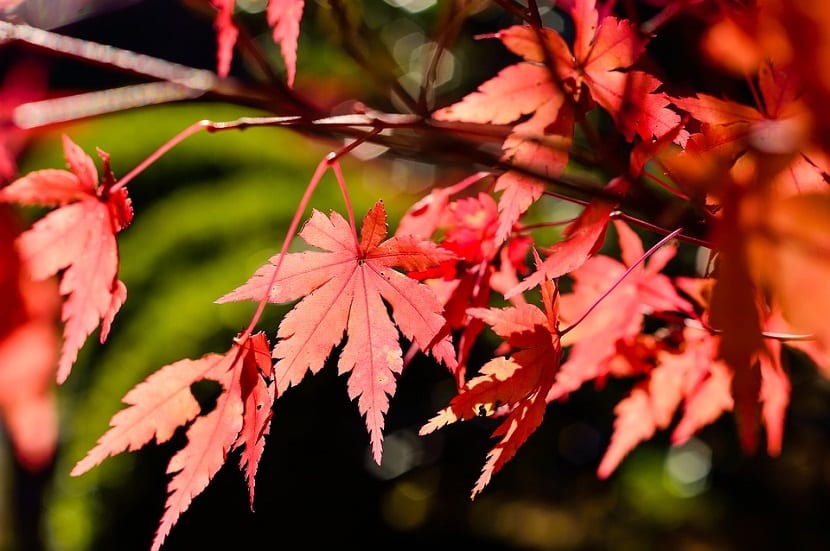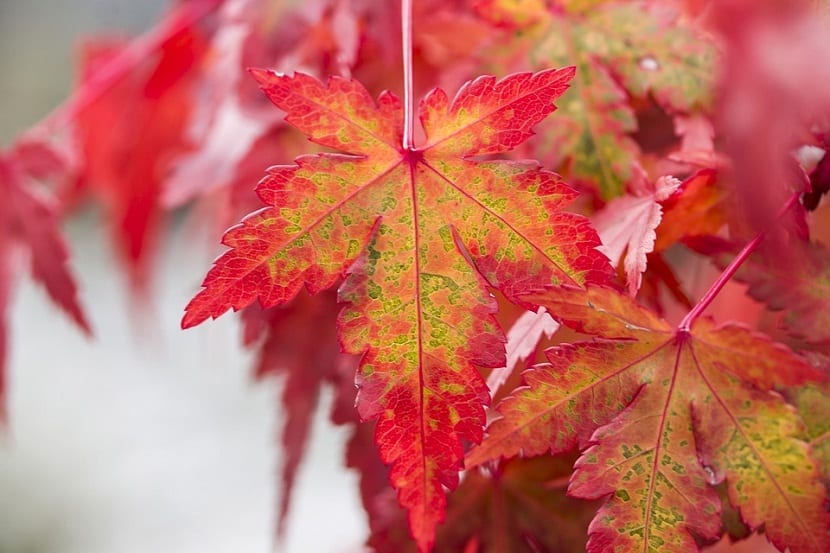
El Japanese maple It is a small tree that can be planted in a garden as well as in a pot, since if it is pruned properly, its growth is controlled very well. It is characterized by its open palm-shaped leaves which makes it very attractive, while it is considered elegant, strong and rustic.
It is one of the favorites when it comes to grow bonsai.
Other characteristics of Japanese maple

Also know as "acer palmatum”The Japanese Maple is a small shrub that lose the leaves every fall, just after changing its color to a reddish tone, its origin is in Japan and South Korea.
It can reach up to 10 meters and in some very specific cases up to 15 meters, with webbed leaves that end in a point.
Japanese Maple gives small flowers with 5 petals each and they appear in the spring, when the autumn arrives the seeds contained in them fall along with all the foliage.
It is capable of withstanding temperatures of up to 30 degrees.
Subspecies that come from the Japanese Maple
Matsumurae, it is distinguished because its leaves are considerably larger and whose edges are much more serrated than the other subspecies, it is native to Japan in high parts
palmatum, slightly smaller leaves and also very serrated, resides in the central and southern regions of Japan in low places
amoenum, its leaves reach diameters of up to 10 cm and reside in the highest parts of Japan and Korea
How is Japanese maple grown?
Japanese maple crops are obtained by means of grafts that make the growth much more expeditious and with certain specific characteristics such as the leaf color or original plant size And in any of the cases, whoever wishes to obtain a maple from a graft must know that it will not grow more than 5 meters.
In such a way that crops are made up of a series of plants, product of mutations or artificial selection with a long tradition, that is why there are more than 1000 specimens of maples from grafts.
Here are some of the crops most commonly can be found in nurseries and that we can have in our garden or pot.
- Atropurpureum, well known and appreciated for its reddish leaves that do not change with the season
- Bloodgood, comes from cultivating atropurpureum and has a greater tolerance to high temperatures
- Butterfly, its leaves are distinguished from others because the edges are white
- Dissectum, They are distinguished by leaf shape that emulate the tip of a needle
- Katsura, are distinguished by their leaves that combine the yellow color, with green and a hint of orange
- Little Princess, it's a small bush, barely reaches 2 meters and with irregular shapes
- Osakazuki, is small and its strength is the bright red color that its leaves take in the autumn
- Sango Kaku, qualify him as a beautiful tree that draws attention due to its leaves, which turn pink or red when fall arrives
- Seiryu, leaves with small cuts whose color in the fall is mixed between orange and red
How to care for a Japanese maple?

If you have it in a pot, you will need good drainage and a surface or substrate with a controlled PH, it is suggested to search the market for specific substrates for plants that thrive better in environments with high acid content.
Must be water frequently To prevent them from drying out, it is even suggested to add lemon juice to the irrigation water (proportionally), also avoiding direct sunlight, but keeping it in a bright place.
It is recommended that they be transplanted every 2 years mainly, if the substrate is very spongy.
I ASK IF I WANT TO SEE A BACKGROUND ARTICLE HOW DO I HAVE TO DO IT SPECIFICALLY ABOUT DIPLODEMIA
Antonio
Hello Antonio.
From the dipladenia we have this article.
A greeting.